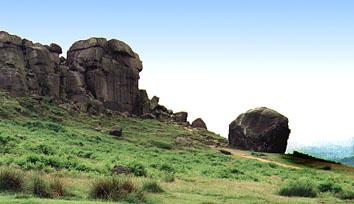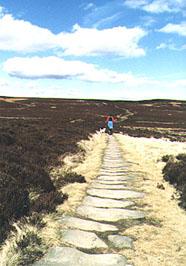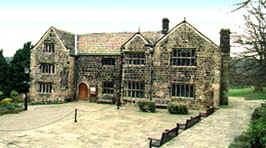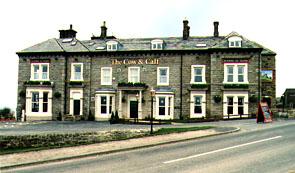Yorksview
Ilkley
'Yorkshire's Heather Spa '
| Ilkley, meaning 'woodland clearing of a man called Yllica.' I love the place, it's a town in a superb setting, lying in a valley lined with heather-clad moors. When I've made my pile, and it's time to 'put my feet up,' I'd like to settle here. It is the pivot of Wharfedale, undoubtedly the most popular of all the Yorkshire Dales. The area offers some of the most spectacular and unspoilt scenery in the land. For the walker it gives unrivalled tramping ground. High up on the moors next to the white-walled cottage of White Wells (where donkeys once carried gout-ridden gentlemen to be doused in the icy-cold moorland spring) you will see a carefully landscaped Victorian scene including two semi-artificial lakes with shelters, planted trees and paths. |
The Cow and Calf Rocks |
Though the town is quite large and fringed with modern housing estates, this is still typical Dales countryside. Ilkley has been attracting visitors of various kinds for ages. Here was an Iron Age settlement where the conquering Romans built a small camp in AD79 to guard a significant crossing of the River Wharfe where their military roads from Ribchester, Bainbridge, Boroughbridge and York all met. Just behind Ilkley's medieval church you can see a flat-topped grassy hump where a little fort was built. Altars carved in local gritstone in homage of far off Mediterranean Gods and Goddesses can be seen in the town's Manor House museum. Three fine Anglo-Norse carved gravestone crosses are kept in the Parish Church. They bear witness to later invaders who anglicised the Romano-British name 'Olicana' to Ilkley, adding the more familiar Anglican 'ley,' or pasture, for the little settlement.
|
Rombald's Moor |
Whilst the nearby towns of Otley and Skipton bustled with life as important market towns, Ilkley was just a sleepy place. Then, in the 18th century, everything changed. Someone discovered the healing powers of the ice-cold waters of the moorland spring at White Wells. Squire Middleton, built a small bath-house to accommodate a stone bath in which to immerse the emaciated limbs of those elderly patients who had been carried up the hill. This became very popular and by the end of the century, served by the new and busy turnpike road between Otley and Skipton, boarding houses and eventually hotels were built to cater for genteel patients taking the cure. Ilkley - 'The Heather Spa' - was born. Early Victorian times saw the development of the great hydros - hydropathic treatment hotels - to provide hot and cold water treatments based on the ideas of Vinzenz Priessnitz, a Silesian farmer, who, in 1843, opened Britain's first hydro at nearby Ben Rhydding. Today these establishments would be known as Health Farms. In a small garden on The Grove you'll find the remains of one of Ilkley's actual chalybeate (iron) springs, sadly it has dried up, and a large marble bath dedicated to the memory of Vinzenz. |
The railways brought folk from Leeds and Bradford in the mid 1800's, and with the growth of the Yorkshire woollen industry, Ilkley became a fashionable commuter town. Mill owners and the 'better off' came here, not only to enjoy the superb amenities, but to build grand homes in rugged West Riding gritstone. If Bradford was where they made their 'brass' (money), it was Ilkley where they spent it.
| Some of Ilkley's real
delights are up on the moors, you can see the Swastika Stone, one of
Yorkshire's most curious monuments. This is a boulder carved with an
ancient Swastika, supposedly the symbol of fire worship, dating back to
Bronze-Age times, there are only three of these in the world, the others
are in Sweden and Greece.
|
Manor House Museum |
|
The Cow & Calf Public House |
The distinctive mass of the Cow and Calf Rocks form a striking landmark. The Cow is a huge gritstone outcrop which conceals an old quarry, the free-standing Calf is a huge boulder. Apparently the Calf had a 'Daddy' called the Bull rock, but this was broken up and used for building material. It wouldn't have sounded right though would it, The Bull, Cow & Calf Rocks? Legend has it that the Calf was knocked there by the giant known as Rombald whilst being chased by his wife! |
| A perfectly preserved Victorian arcade is situated near the large car-park. The town still has a Victorian and Edwardian feel to it. Splendid shops, pubs, restaurants and cafés adorn the tree-lined streets. Betty's, without doubt the finest tea shop in Yorkshire, and therefore the world, is situated on The Grove. Such delicacies as 'Yorkshire Fat Rascals' can be purchased here. Ilkley has many more interesting shops. Lovely parkland, boating on the river and family picnic areas provide pleasure for all. One of the greatest things I like about Ilkley is the fact that it is the starting point of the 84 mile-long 'Dales Way' walk, which is breathtakingly beautiful! You tramp through some of Yorkshire's finest places and finish at Bowness in the Lake District, taking in the delights of Bolton Abbey, Burnsall, Grassington, Kettlewell, Hubberholme, Yockenthwaite, Cam Houses, Dent, Sedbergh, Lincoln's Inn Bridge and Burneside. If you've never walked the Dales Way, then stop whatever you are doing right now and get on a bus, a train or a 'plane and get down to Ilkley to begin the walk of a lifetime. One thing's for sure, you'll return a much better person! |
The old humpbacked bridge, starting point for the 'Dales Way' walk |
'Moor likely Ilkley' is my motto!




